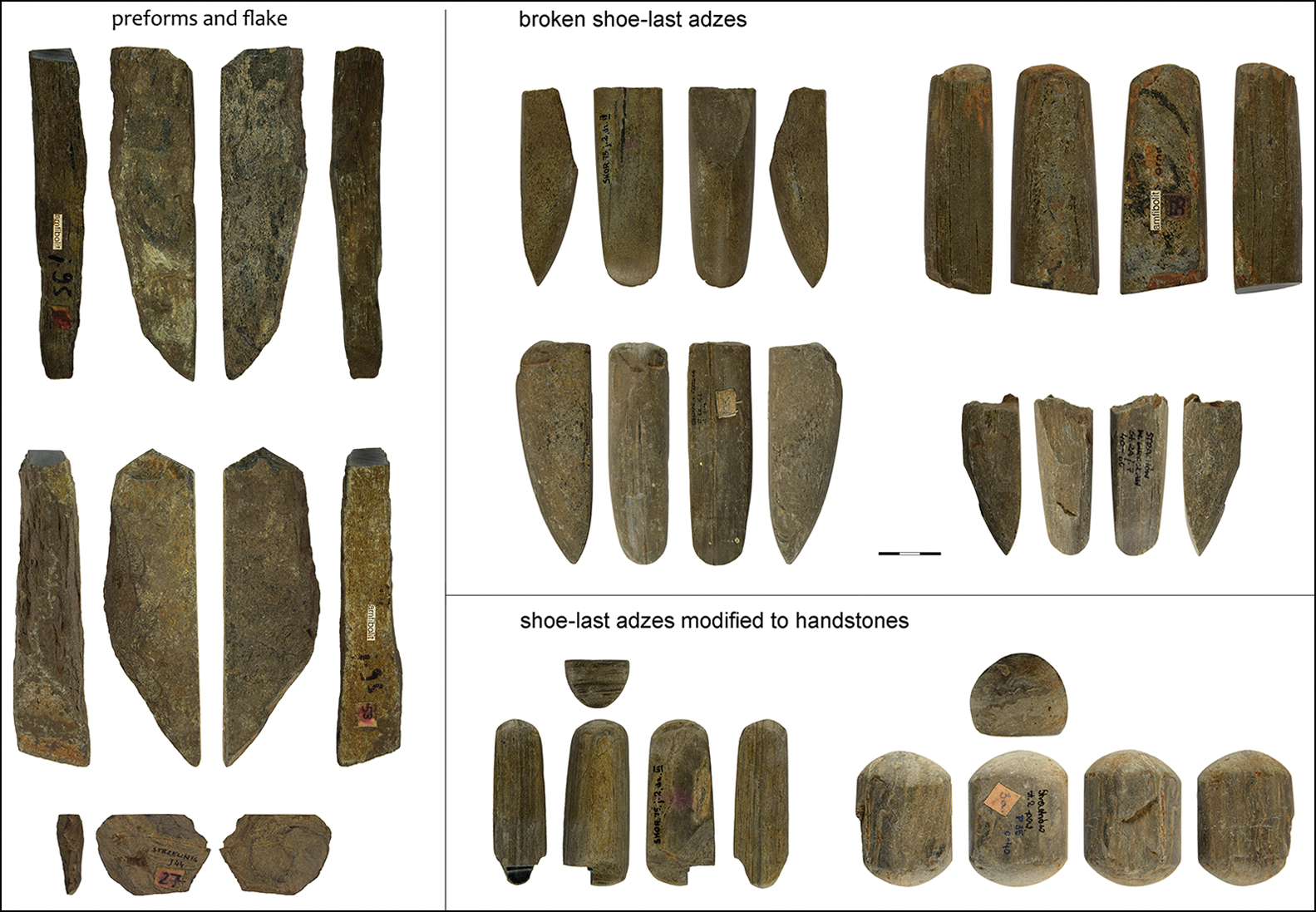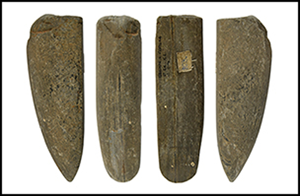Introduction
Studies of the Central European urnfield traditions (c. 1300–550/400 BC, depending on region) have brought to light interesting examples of older objects incorporated into funerary ritual. Tools made of flint or non-siliceous rocks were deposited with cremated bones and ceramic items. In this article, we present the analysis of a ground stone adze from a grave in an extensive urnfield at Miłosławice, south-west Poland. This cemetery contains burials dated to the later Bronze Age and Early Iron Age (Lasak et al. Reference Lasak2008) (Figure 1), representing funerary traditions typical for this region and these periods, and including numerous ceramic vessels and grave goods made of materials such as bronze, iron, glass, amber and flint.

Figure 1. Location of the Miłosławice 6 site: A) distribution of Neolithic Linear Pottery Culture sites (pink dots): B) selected Mesolithic sites (green rhombuses) (drawn by M. Chłoń).
Grave no. 527 and the adze
This grave was furnished with a large vase (urn), which was covered with a ceramic plate decorated with fingerprints, and 25 smaller vessels (Figure 2A). The pottery can be dated to Hallstatt C (750–550 BC) based on its style and decoration (e.g. geometrical motifs burnished on the inner surface of the bowls). Although the shape of the grave pit was irregular, the vessels were arranged in a line, suggesting the presence of another structure, possibly a chamber. The urn contained the cremated bones of an adult (561g) and an animal (21g) (Dąbrowski & Szczurowski Reference Dąbrowski and Szczurowski2008). The ground stone adze was placed to the right of the urn. It is a tool type characteristic of the Linear Pottery Culture (Linearbandkeramik, hereafter LBK; c. 5600–4900/4800 BC in south Poland) toolkit.

Figure 2. Grave no. 527 (A) and the shoe-last adze (B) from Miłosławice (scale in cm) (drawn by J. Baron; photograph by Ł. Melski).
The adze represents one of two types observed in the LBK: a low variant of a shoe-last adze, with a height-to-width ratio of less than 1:1, a typically plano-convex cross-section and parallel sides (Czekaj-Zastawny Reference Czekaj-Zastawny and Włodarczak2017: 49). The adze is complete and measures 142 × 33.6 × 22.6mm (Figure 2B). It was produced from Jizera Mountains-type metabasite from outcrops located in the Bohemian Massif, approximately 200km south-west of Miłosławice (M. Borowski, pers. comm.).
Methods
Macro- and micro-traces were analysed to identify the stages of manufacture, utilisation and reuse using an Olympus SZX9 stereomicroscope (6.3–114×), a Nikon ECLIPSE LV100 metallographic microscope (50–500×) and a Nikon Digital Microscope ShuttlePix P-400R. The raw material was identified macroscopically using a Kappameter KM-7.
Results
Evidence of production is limited to flake negatives relating to final flaking of the butt (Figure 3D) and traces of grinding on the upper surface. The latter display as linear grain extractions parallel to the main axis (Figure 3A). The bottom surface displays extreme levelling (Figure 3B), as well as a bright, matt gloss without any clear direction (Figures 3C & 3F). A similar gloss, resulting from polishing and hafting, is visible on both lateral edges. No linear traces of whetting were recorded on the flat bottom surface. Nonetheless, the central part is damaged and exhibits a concentrated area of irregular grain extractions (Figure 3G). The original cutting edge was removed via secondary activity involving striking from the upper side, which prevents identification of the tool's original function. This striking activity produced large flake negatives with coarse surfaces, consequently providing the cutting-edge with an irregular profile (Figure 3E). The butt is rounded but does not bear any traces of use (Figure 3H).

Figure 3. Shoe-last adze from Miłosławice (drawn by N. Lenkow). Traces of production and use (marked with red arrows and box): A) linear grain extractions; B) surface levelling; C) bright polish; D) flaking scars; E) secondary negatives; F) matt polish; G) grain removal on surface; H) butt rounding (photographs by B. Kufel-Diakowska).
Discussion
The question we must answer now is how did the tool come into the possession of Early Iron Age people? This is not an isolated phenomenon, as Neolithic tools are frequent finds within Iron Age burials in Poland (see Gackowski & Osipowicz Reference Gackowski and Osipowicz2013). In addition, a similar specimen has been recovered from a Late Bronze Age grave at Battaune, in present-day Germany (Schmalfuß Reference Schmalfuß2008).
As mentioned above, the Miłosławice adze was made from Jizera Mountains-type metabasite, which is comparable to most of the adzes so far found in Central European LBK contexts (Krystek et al. Reference Krystek2011; Verhart Reference Verhart2012; Borowski Reference Borowski and Furmanek2019). Although metabasite mining is known to have occurred in the Hallstatt C and D periods (c. 750–400 BC), the use and distribution of metabasite ground tools has only been confirmed for LBK and post-LBK cultures (Přichystal Reference Přichystal2013). Přichystal (Reference Přichystal2013) suggests that such adzes were manufactured at workshops near the outcrops and distributed as finished tools. Both pre-forms and flakes, however, have been identified at LBK sites in south Poland (Wojciechowski & Cholewa Reference Wojciechowski and Cholewa1995; Czekaj-Zastawny Reference Czekaj-Zastawny and Włodarczak2017) (Figure 4); thus, local manufacture cannot be ruled out.

Figure 4. Examples of pre-forms and shoe-last adzes from south-western Poland (photographs by Ł. Melski).
The tool, therefore, was almost certainly retrieved from an earlier context. Complete, low variants of shoe-last adzes do not occur in the LBK assemblages in south-west Poland, however (Wojciechowski & Cholewa Reference Wojciechowski and Cholewa1995; Kulczycka-Leciejewiczowa Reference Kulczycka-Leciejewiczowa1997). The closest comparisons to this type of tool originate from LBK cremation graves near Kraków, around 300km south-east of Miłosławice (Czekaj-Zastawny Reference Czekaj-Zastawny and Włodarczak2017). They are suggested to have been used for woodworking or preparing land for cultivation, including felling trees and ploughing (Verhart Reference Verhart2012; Elburg et al. Reference Elburg and Kelm2015; Czekaj-Zastawny Reference Czekaj-Zastawny and Włodarczak2017). Although the primary function of the Miłosławice adze is impossible to determine, the hafting polish may suggest its use during the Neolithic period. Thereafter, the tool was subjected to secondary modification. Its cutting edge, however, displays atypical damage when compared with other exhausted LBK adzes, which are most often transversally broken or reused as handstones for grinding (Figure 4).
We must also consider indirect acquisition from outside of a Neolithic context. Szydłowski (Reference Szydłowski2017: 101) reports examples from Poland of LBK metabasite adzes being modified to form Eneolithic ground stone axes. Miłosławice, however, lies outside the main LBK settlement zones within Poland (Figure 1) and is located near few Eneolithic sites (Kulczycka-Leciejewiczowa Reference Kulczycka-Leciejewiczowa1993: supplementary material). Instead, Miłosławice is situated in a dune landscape that was densely settled in the Mesolithic. Despite the scarcity of local data confirming close ties between hunter-gatherers and the first farmers, evidence from Central and North-west Europe (Devriendt Reference Devriendt2014) indicates the existence of bilateral contacts, including an LBK stone adze found in a Mesolithic grave in Germany (Lenneis Reference Lenneis2007). Thus, it is possible that a Mesolithic community might have obtained the Miłosławice adze through exchange. After its use and deposition, Early Iron Age people have retrieved it and finally utilised it for funeral purposes. While this latter explanation is thought to be most likely, contacts between the Late Mesolithic Komornica Culture and the LBK need to be further explored.
Funding statement
This study is part of a project supported by the National Science Centre, Poland (2020/38/E/HS3/00285).






